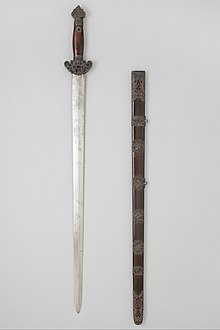| Jian | |||||||||||||
|---|---|---|---|---|---|---|---|---|---|---|---|---|---|
 Single-handed jian and scabbard of the 18th–19th century | |||||||||||||
| Traditional Chinese | 劍 | ||||||||||||
| Simplified Chinese | 剑 | ||||||||||||
| |||||||||||||
The jian (Mandarin Chinese: [tɕjɛ̂n], Chinese: 劍, English approximation: /dʒjɛn/ jyehn, Cantonese: [kim˧]) is a double-edged straight sword used during the last 2,500 years in China. The first Chinese sources that mention the jian date to the 7th century BCE, during the Spring and Autumn period;[1] one of the earliest specimens being the Sword of Goujian. Historical one-handed versions have blades varying from 45 to 80 centimeters (18 to 31 inches) in length. The weight of an average sword of 70-centimetre (28-inch) blade-length would be in a range of approximately 700 to 900 grams (1.5 to 2 pounds).[2] There are also larger two-handed versions used for training by many styles of Chinese martial arts.
Professional jian practitioners are referred to as jianke (Chinese: 劍客; pinyin: jiànkè; lit. 'sword guests' or "swordsmen"; a term dating from the Han dynasty).[3]
In Chinese folklore, the jian is known as "The Gentleman of Weapons" and is considered one of the four major weapons, along with the gun (staff), qiang (spear), and the dao (sabre). These swords are also sometimes referred to as taijijian or "tai chi swords", reflecting their current use as training weapons for tai chi practitioners, though there were no historical jian types created specifically for tai chi.[4]
- ^ Ebrey 1999, p. 41.
- ^ Rodell 2003, p. 19
- ^ Lorge 2011, p. 69.
- ^ Rodell 2003, p. 20.